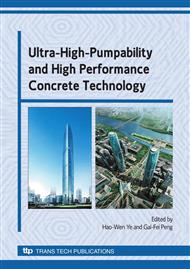p.14
p.19
p.24
p.30
p.37
p.44
p.50
p.55
p.62
Mix Proportion Optimization and Shrinking of New Developed Reactive Powder Concrete
Abstract:
According to the theory of dense packing of particle, the theoretical particle size distribution of raw materials of RPC (Reactive Powder Concrete) was calculated. On the basis, the ratio of raw materials with different range of particle sizes of the RPC was determined by mechanical experiments. According to the determined ratio, a new type RPC was prepared by using flying ash and slag to replace part of cements and quartz flour, respectively. The workability, mechanical properties of the new RPC with different mix proportion and its shrinkage, cured at the normal temperature and 60°C, respectively, were studied. The results show that when water-binder ratio is 0.23, fly ash replaces 30% cements, slag replaces 50% quartz flour and superfine steel fibers percentage in volume is 2%, the compressive and flexural strength of prepared RPC are 160.1MPa and 25.3MPa, respectively, and after 3days heat curing (60°C), the dry shrinkage of it in 28days age reaches 299um/m. In addition, the fluidity of the new RPC is 258mm and meets requirements of workability of the pump concrete.
Info:
Periodical:
Pages:
37-43
Citation:
Online since:
January 2009
Authors:
Price:
Сopyright:
© 2009 Trans Tech Publications Ltd. All Rights Reserved
Share:
Citation:


